Resistance Training
Resistance training is the use of force to muscle contraction to increase skeletal muscle size, strength, and anaerobic endurance. The foundation of resistance training is the idea that when the body is forced to overcome a resistance force, its muscles will do so. Your muscles get more powerful when you do resistance practice daily.
Resistance training increases muscle tone and strength while preventing joint damage, so it’s a great option whether you’re thinking about working out at home or adding to your gym routine. In addition to helping you maintain flexibility and balance, it’s a relatively affordable option that can support your weight management goals.
Particularly as you age, these advantages are significant. Age-related muscle loss should be avoided, even though greater strength and mobility are beneficial for people of all ages. Learn more about resistance training in this section, along with how to begin.
What Is Resistance Training?
A type of exercise called resistance training aims to improve muscle endurance and strength. It involves exercising the muscles with resistance. You could use weights, bands, or even your body weight defying gravity as resistance. You can concentrate on achieving particular goals when performing resistance training, also known as strength training or weight training, such as improved joint stability, increased muscle size, strength, and power.
The Centers for Disease Control and Prevention (CDC) recommends doing moderate-to-intense muscle-strengthening exercises two or more days a week. All the main muscle groups should be worked during these exercises. The CDC suggests three hours of resistance training per week for kids.
Strength training enhances bone density, muscle, tendon, and ligament strength; it also improves heart and lung fitness. Aerobic exercises, flexibility, and balance exercises are all components of a well-rounded fitness program. Adults should engage in muscle-strengthening activities at least twice a week, according to Australia’s guidelines on physical activity and sedentary behavior. Step up your resistance training schedule every six to eight weeks to keep your progress steady.
The following variables may affect your results:
- Sets.
- Repetitions.
- Exercises undertaken.
- Intensity (weights used).
- Frequency of sessions.
- Rest between sets.
You can maintain the strength gains you achieve in resistance training by varying the exercises, weights used, and number of repetitions and sets performed.
How Does Resistance Exercise Work?
Resistance training functions by creating small tears or tears in the muscle fibers, which the body swiftly repairs to support the muscles’ growth and regeneration. The process of breaking down muscle fibers is known as “catabolism,” while the process of repairing and growing new muscle tissue is known as “anabolism.” The term “anabolic” is probably familiar to you from using steroids.
Resistance training causes the muscle fibers to break down, and this is exactly what happens when anabolic means to grow. The body needs to undergo some catabolism or breakdown, for many biological processes that lead to growth to resume. To break down bones, for example, is a prerequisite for the repair and strengthening of bones by growth factors such as calcium.
Following a session of resistance exercise, muscles receive an increase in growth hormone, insulin-like growth factor, protein, and other nutrients, which aid in muscle repair and increase muscle strength. Recovering from a workout requires time off because, crucially, your muscles grow and heal during this period.
Why Resistance Training?
Resistance training has many established health advantages, and new studies are showing how crucial it is for Americans to participate in this type of exercise. The building of shelter, hunting, farming, and all the other manual labor-intensive tasks required for survival gave humans’ muscles a great workout in hunter-gatherer societies long ago.
To the extent that our muscles hardly ever need to be pushed very hard, though, we have labor-saving devices built in inactivity into our lives today. We send people moving to climb stairs and even walk through airports, clean our clothes and dishes, and even operate vacuums. we don’t take a special time to perform resistance activities, you have to get some break from your work and do some light bodyweight exercises. According to research, being sedentary is the second most common preventable cause of death in the US and is killing people.
Basic principles of resistance training
There are different components to resistance training. Basic concepts are made up of:
- Program – Exercises like aerobic training, flexibility training, strength training, and balance exercises make up your overall fitness program.
- Weight – During your strength training session, various weights or resistance types—such as a rubber band, body weight, or a 3 kg hand weight or fixed weight—will be used for various exercises.
- Exercise – an exercise routine, like calf raises, that targets and strengthens a specific muscle or group of muscles.
- Repetitions or reps – this is used to describe the number of times you consistently perform each exercise in a set.
- Set–sets are a series of exercises done without taking a break. For example, two sets of 15 reps of squats would require you to perform 15 squats, rest your muscles, and then perform another 15 squats.
- Rest –You must take breaks in between sets. The length of a rest period varies with the level of exercise.
- Variety – Changing up your fitness routine, such as adding new exercises regularly, puts your muscles to the test and makes them stronger and more adaptable.
- Progressive overload principle – Progressive overload theory states that to keep getting stronger, you should work out until it becomes difficult for you to perform the exercise again. The goal is to challenge yourself with a suitable weight or resistant force while keeping proper form. Making consistent changes to the training factors, such as frequency, duration, number of exercises for each muscle group, sets, and repetitions, will also help you progress and improve.
- Recovery –Post-exercise, muscles require time to recover and adjust. When working the same muscle group again, it’s a good idea to give it up to 48 hours of rest.
Modalities of Resistance Training
There are many ways to provide resistance, and using weights is just one of them. Gravity, inertia, fluid resistance, and elastic resistance are further methods.
Gravity
Since all objects have mass, their mass and density are impacted by Earth’s gravity. The gravitational forces acting on an object designed for comfort and repeated use are what people mean when they say they use weights for training. The principles of biomechanics state that resistance training with weights differs greatly from machine training. The fundamental idea behind resistance training is that any force applied to an object must act downward.
Inertia
A body at rest tends to stay at rest, and a body in motion tends to stay in motion unless the body is acted upon by a force, according to Isaac Newton’s first law of motion. According to Newton’s second law, force (abbreviated F = ma) is equal to mass times acceleration. Because of this, an object with a small mass needs a higher rate of acceleration than an object with a larger mass would require when applying the same force. When engaging in resistance training, the downward force of gravity on a given mass (weights or a body subject to gravitational forces) is equal to the force exerted by agonist muscles at a constant rate on the mass.
Any acceleration causes inertial resistance and gravitational pull to act on the mass being moved. The accelerative force applied to the object from the opposite direction equals the inertial resistance. For example, the initial force required to lift a 132-pound (60-kg) barbell off the ground must be greater than 132 pounds because the force must accelerate to overcome both the gravitational and inertial forces. It is not necessary to apply as much force to perform multiple repetitions once the initial force is applied to the object.
Fluid resistance
Swimming is a prime example of fluid resistance training. In that situation, water acts as the fluid resistance. Sports like golf, baseball, and cycling also involve fluid resistance. Such actions are instances of air resistance. Surface drag and form drag are the two ways that water and air resist. An object can be moved by a different dynamic of collective forces due to the interaction of inertial and gravitational forces with the friction of the water and air.
Elastic resistance
Elastic resistance can be achieved with springs, tubing, and heavy-duty rubber bands. The idea behind elastic resistance is that more force is required to overcome the resistance the more stretched out the band or spring is. The muscle won’t be able to perform an exercise’s full range of motion if the density is too high. Elastic resistance can be combined with fluid resistance and gravitational resistance to provide the muscle with yet another variable to adjust to.
Benefits of Resistance Training
Though resistance training has many other health advantages, its main goal is to improve muscular strength and endurance. The following are some advantages of adding resistance training to your fitness routine.
Resistance training has several advantages for both mental and physical health, including:
- Strengthened and toned muscles to prevent damage to your joints.
- As you get older, maintaining your balance and flexibility can help you stay independent.
- Weight management and a higher muscle-to-fat ratio: an increase in muscle mass increases resting-energy expenditure (KJ).
- May aid in preventing or avoidance of older people’s cognitive decline.
- Increased stamina: You won’t tire out as quickly as you get stronger.
- Chronic illness prevention or management, including diabetes, heart disease, back pain, rheumatism, depression, and obesity.
- Pain control.
- Enhanced balance and mobility.
- Improved alignment of the posture.
- Reduced risk of injury.
- Enhanced well-being – engaging in resistance training can help you feel more confident, better about your body, and happier.
- Better sleep and prevention of insomnia.
- Improved self-esteem.
- Improved performance of daily tasks.
Boost Metabolism and Reduce Body Fat
Resistance training may help you achieve your weight loss goals. Resistance training can increase your metabolism, according to studies. An individual’s resting metabolic rate can be significantly increased with resistance training for nine months, according to one study.
If you do resistance training consistently, you can alter your metabolism significantly in less than a year. Even more effective than aerobic exercise at increasing your metabolism is resistance training, according to more research. If you wish to experiment and alter your routine, this information may be very beneficial. However, this does not imply that cardio is ineffective; research suggests that resistance training may be a better way to increase your metabolism. To get the best effects, try combining the two types of exercise.
Increase Bone Density and Improve Balance
Exercise that involves resistance can also strengthen your bones. Regular resistance training has been shown in studies to either preserve or improve bone mass and density. Resistance training can also aid in enhancing stability and balance. It becomes increasingly crucial as you get older.
For example, fifty older adults were randomized into a training group or a control group for a study on balance improvement. The training group completed leg extensions and curls throughout the 12-week study. When that time came to an end, the training group’s balance was noticeably better than that of the control group, according to the researchers.
Improve Mental Health
There are other reasons to start exercising besides improving your physical health. Exercise is frequently suggested by medical professionals as a way to enhance mental health. Your daily experiences and quality of life are significantly impacted by your mental and emotional well-being.
According to a study focused on improving older adults’ quality of life, resistance training enhanced mental, emotional, social, and physical functioning. Subsequent research has revealed that resistance training, even at low enough intensities to not significantly increase one’s physical strength, can help reduce symptoms of depression.
Additionally, resistance training can assist in reducing overall anxiety and concern. This means that regular engagement in even a small amount of resistance training can help relieve stress and enhance mental and emotional well-being.
Build Muscle Mass
Building muscle mass may be the aim of resistance training for certain individuals. Another name for this process is muscular hypertrophy. This objective is not just for athletes seeking to increase their muscle mass; it’s also for older adults hoping to reduce muscle atrophy or the loss of muscle mass.
Whatever your objective, resistance training is a great way to gain muscle mass. Studies have shown that concentrating on mechanical tension and metabolic stress is the most effective way to gain muscle. Getting results from this kind of training program requires perseverance.
Improve Muscle Strength and Endurance
Achieving more muscle mass and strength is not just for show; it can also help support the health of your muscles and improve your general quality of life. In your daily life, muscle endurance and strength are important particularly as you age.
You can support the health and functionality of your muscles with resistance training. Your muscles, for illustration, support you when completing simple tasks like lifting things, opening containers, or even engaging in lengthy physical activity. You can connect your level of resistance exercise with your muscle strength and endurance, per one study. Improve the quantity of resistance training you do by expanding the length of time or frequency if you want to gain more strength or endurance.
Reduce the Risk of Sports Injuries
Typical resistance training may benefit children and adolescents to avoid muscle injury when participating in athletics. Of course, the workout performance for a child would not be the same as it would be for an adult. Consult a professional trainer when creating a workout pattern for a child or adolescent.
Increase Self-Esteem
While resistance exercise can assist you tone your muscles and even increase their size if that is your goal, it also can assist you build confidence and increase your self-esteem. Experimenters note that engaging in resistance training can increase self-esteem, especially in women.
Investigators observed that following a resistance training session, study participants felt energized in one analysis of college women. They also showed that they had enhanced self-concept, self-esteem, and self-efficacy, as well as enhanced overall perspective.
Adaptations to resistance training
Acute and chronic adaptations to resistance training are possible. Resistance training mainly causes acute reactions in the endocrine, muscular, and neurological systems. Resistance training can cause long-term effects on the neurological, endocrine, skeletal, and muscular systems. Chronic adaptations to resistance training are also thought to include anthropometric (body composition) adaptations.
Neurological
A signal is sent to a muscle upon application of force, activating the muscle cells. Resistance training increases the quantity and strength of signals sent to a particular muscle until the muscle becomes fatigued. Muscle force is controlled by two neurological processes: rate coding and motor unit recruitment.
For a particular task, the first term refers to the magnitude of the force generated by a muscle contraction. When doing a biceps curl with a 10-pound (4.5-kg) dumbbell, for instance, fewer motor units in the biceps brachii muscle are recruited than when using a 50-pound (22.5-kg) dumbbell.
The dimension principle, which states that motor units that recruit slow-twitch fibers recruit fewer fibers than motor units that recruit fast-twitch fibers, is the basis for motor unit recruitment, according to kinesiologist and author Roger Enoka. Motor unit firing is controlled by rate coding. With each repetition of a particular movement pattern during resistance training, the muscles get more and more fatigued, impairing rate coding and firing sequence precision.
Long-term neurological changes lead to a more effective recruitment order for motor units, which reduces the likelihood that neuromuscular factors will cause the muscle to fatigue. Decreased antagonist muscle co-contraction and enhanced motor unit firing are two more long-term neurological system adaptations.
When the agonist and antagonist muscles fire simultaneously, this is known as co-contraction. Greater movement efficiency is made possible by a decrease in the co-contraction of antagonist movement when the agonist muscles are being used.
Muscular
The acute effects of resistance training on muscle include the depletion of metabolic substrates like glycogen and creatine phosphate. Muscle power production decreases during resistance training due to the depletion of those two fuel sources. The intramuscular elevation of hydrogen during resistance training is another important acute muscle adaptation.
Repeatedly using that causes the muscles to feel as though they are “burning.” The intramuscular pH decreases as a result of the muscle’s increased concentration of hydrogen ions. Muscle hypertrophy, or the enlargement of the muscle fibers’ cross-sectional area, is one of the long-term responses to resistance training. Both type I (slow-twitch) and type II (fast-twitch) muscle fibers can undergo hypertrophy; type II muscle fibers, however, respond more strongly.
Resistance training volume and intensity manipulation will, more or less, cause those specific muscle fiber types to hypertrophy. Strength and power are increased by the long-term adaptation of the muscle fibers’ larger cross-sectional area.
Another long-term muscle adaptation that has been demonstrated in animals but not in humans is a condition known as hyperplasia. When the quantity of muscle fibers increases, that happens. Protein synthesis increases proportionally as a result of the ensuing muscle fiber hypertrophy and potential hyperplasia. This is necessary for the acute muscle fiber repair response to resistance training.
Endocrine
The pituitary glands produce two main types of hormones that are affected by resistance training: steroid hormones and protein hormones. Major protein hormones include insulin and growth hormones; major steroid hormones are testosterone and estrogen. Steroid hormones and anabolic and catabolic protein concentrations are both sharply increased by resistance training.
Anabolic hormones such as growth hormones, insulin, and testosterone promote the development and repair of muscle tissue following a resistance training session. On the other hand, both during and after resistance training, hormones known as catabolic hormones—which degrade muscle—are released. Resistance training increases the secretion of cortisol, epinephrine, and norepinephrine, which can have beneficial short-term effects but detrimental long-term effects.
More volume and intensity in a resistance training treatment causes more adrenaline to be released. To avoid a catabolic effect from cortisol, epinephrine, and norepinephrine, it is beneficial to consume proteins and carbohydrates both before and after resistance training. An elevated testosterone level at rest and an enhanced tissue response to protein and steroid protein release are examples of long-term endocrine system adaptations.
Skeletal and body composition
The skeletal system only adapts over an extended period. Studies have shown that regular resistance training increases or maintains bone mineral density (BMD) in postmenopausal women. Osteoporosis, also known as the demineralization of bone, is most common in postmenopausal women. For a BMD improvement, six to eight weeks of consistent resistance training would be required.
Changes in body composition are thought to be a long-term response to resistance training. Fat mass (subcutaneous fat) and fat-free mass (bones, muscle, etc.) make up the components of body composition. Regular resistance training causes muscle hypertrophy, which is the main cause of an increase in fat-free mass. Therefore, the body uses more energy (higher caloric expenditure) to maintain the muscle mass, which results in a decrease in fat mass.
The dermis’s connective tissue also makes the skin more elastic, tightening the skin and giving the body an overall younger appearance. Depending on factors like genetic makeup, training age, gender, and chronological age, the duration of those chronic adaptations varies.
How to get started with resistance training?
You should make a consistent effort to include resistance training in your workouts. You do not need to sign up for a gym membership or pay a personal trainer to start because you can start with just your body weight or even a basic set of dumbbells.
However, you have to make sure that you are performing your workouts with the correct form. In addition to ensuring you are getting the most out of your exercise, using proper form can lower your chance of injury. See a healthcare professional for guidance if you have a medical condition, a disability, or if you are just beginning an exercise program. They can provide you with advice based on your medical history and what is best for you.
It is also crucial to remember that beginning resistance training does not require purchasing any equipment. You can perform exercises like planks, squats, pushups, and more using just your body weight. Alternatively, you can use common household items like unopened bags of flour, canvas bags filled with soup cans, or gallon jugs of water to add additional weight.
Equipment for resistance training
While starting resistance training doesn’t require any specific equipment, the following are some examples of items you can buy for the purpose: Just one barbell
- Dumbbells
- kettlebells
- Bands of resistance
- Trainers for suspension
- Bars that pull up
Regarding starting weight, before utilizing free weights or other equipment, some people prefer to use their body weight.
Examples of resistance training
Various kinds of resistance training include:
- Free weights include traditional strength training tools like kettlebells, barbells, and dumbbells..
- A weighted bag or ball is called a sandbag or medicine ball.
- Weight machines are machines with movable seats and handles that are connected to hydraulics or weights.
- Exercise resistance bands produce resistance, much like stretching enormous rubber bands. They are portable and suitable for a variety of exercises. Because of the bands, there is consistent resistance throughout a movement.
- Suspension equipment is a training tool that allows users to perform a variety of exercises by using their body weight and gravity.
- You can perform chin-ups, push-ups, and squats using just your body weight. It’s convenient to use your body weight, particularly when traveling or at work.
Exercises for bodyweight resistance training
- Weight Bearing Exercises are an excellent way to start once your muscles are warmed up and prepared for action.
- Exercise mats are the only equipment required for bodyweight exercises if the floor is too hard.
- Make sure your movements are controlled, steady, and smooth for each of these exercises.
Warming up before resistance training
Before beginning any resistance training exercises, warm up your body. Initiate a five-minute light aerobic protocol by walking, cycling, or rowing, accompanied by several dynamic stretches. Throughout the entire range of motion, slow, deliberate movements are used in dynamic stretching.
Lunges
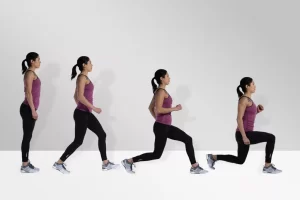
- Your quadriceps, hamstrings, glutes, and calves are among the lower body muscles that are worked during a basic lunge.
- Place your feet shoulder-width apart and stand tall to begin.
- When your left knee is parallel to the floor and your right leg is at a 90-degree angle, step forward with your right foot and lower your hips towards the floor. Make sure your toes are not touched by your front knee.
- To maintain your torso upright, lengthen your spine.
- Keep this posture for at least 5 seconds.
- After that, bring your right foot back to meet your left, then switch to your left leg to complete the motion.
- After 10 to 12 repetitions, take a little break and perform another set. Variations on the lunge include side lunges, walking lunges, jumping lunges, and lunges with a torso twist.
Squat to overhead raise
- Start by raising your arms overhead without any weight if you’re new to strength training. As you gain strength and can perform this exercise with proper form, you can progress to using lighter dumbbells.
- This exercise works the muscles in your stomach, back, shoulders, and triceps in addition to your glutes and leg muscles. Position your arms next to your body and your feet slightly wider than your hips.
- Lower your hips gradually to a squat position.
- Raise your arms above your head and press up to return to a standing position.
- Go back to where you were before.
- Perform 1-3 sets of 8–12 reps.
Planks
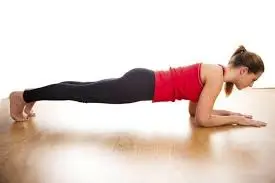
- Doing planks is a great way to strengthen and stabilize your core. The muscles in your shoulders, chest, and back can all be strengthened with this exercise.
- Just rest on your forearms and toes, maintaining a straight body alignment with your abdominal muscles contracted and your buttocks clenched.
- For thirty seconds, try to maintain this posture. If that’s too difficult, try 20 seconds first.
- Try to maintain the plank position for at least one minute as your strength and fitness increase.
- When you’re prepared for a more difficult plank, try lifting one leg at a time while maintaining the plank posture.
Pushups
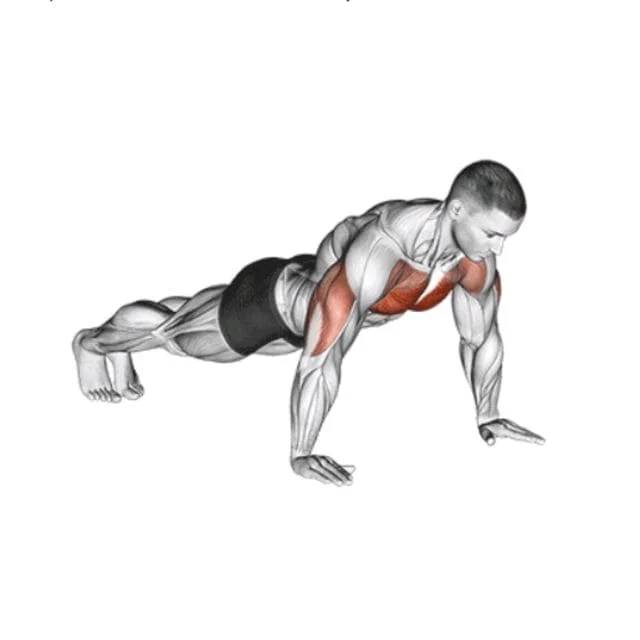
- Standard pushups engage the shoulder, triceps, and abdominal muscles in addition to the chest muscles (pectorals).
- Place your palms right beneath your shoulders to begin in the plank position.
- Bend your elbows until your chest nearly touches the floor while maintaining a flat back and strengthening your core.
- Reposition your body to the beginning position right away.
- Do this eight to twelve times. As you gain strength, work your way up to three sets, starting with one or two.
- You can perform a less strenuous variation of the pushup by supporting your weight with your knees rather than your toes.
- Plyo pushups, pushups in a closed stance, and decline pushups are some of the more difficult pushup variations.
Free weight exercises
- We use dumbbells for the next two exercises. With five-pound dumbbells, start small. You may switch to using dumbbells that weigh eight or ten pounds as you gain strength.
- In addition to dumbbells, you can substitute cans or water bottles. For safety’s sake, just make sure you hold them tightly.
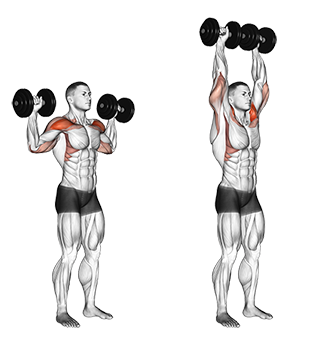
Dumbbell shoulder press
- In addition to strengthening your core and chest muscles, this exercise targets the muscles in your arms and shoulders.
- Position your feet shoulder-width apart when you take a starting position.
- Raise the dumbbells to shoulder height after picking them up. You can place your palms facing your body or forward.
- Lift the dumbbells above your head and extend your arms completely.
- After a short amount of time working in this posture, return the dumbbells to shoulder height.
- Perform 1-3 sets of 8–12 reps.
Dumbbell triceps kickback
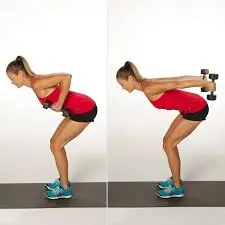
- This exercise targets the muscles in your shoulders as well as your triceps.
- Hold one dumbbell in each hand after grabbing two.
- Bend your elbows to a 90-degree angle while bending your torso to a 45-degree angle.
- Next, extend your arms straight behind you while contracting your triceps.
- One arm at a time or both at once can be performed.
- As you gain strength, work your way up to three sets of eight to twelve repetitions if you’re just starting away.
Resistance band exercises
- An additional excellent tool for your strength training regimen is a resistance band. In addition to being portable and lightweight, a 2010 study revealed that they effectively engage your muscles in the same way as free weights or weight machines.
The resistance band pulls apart
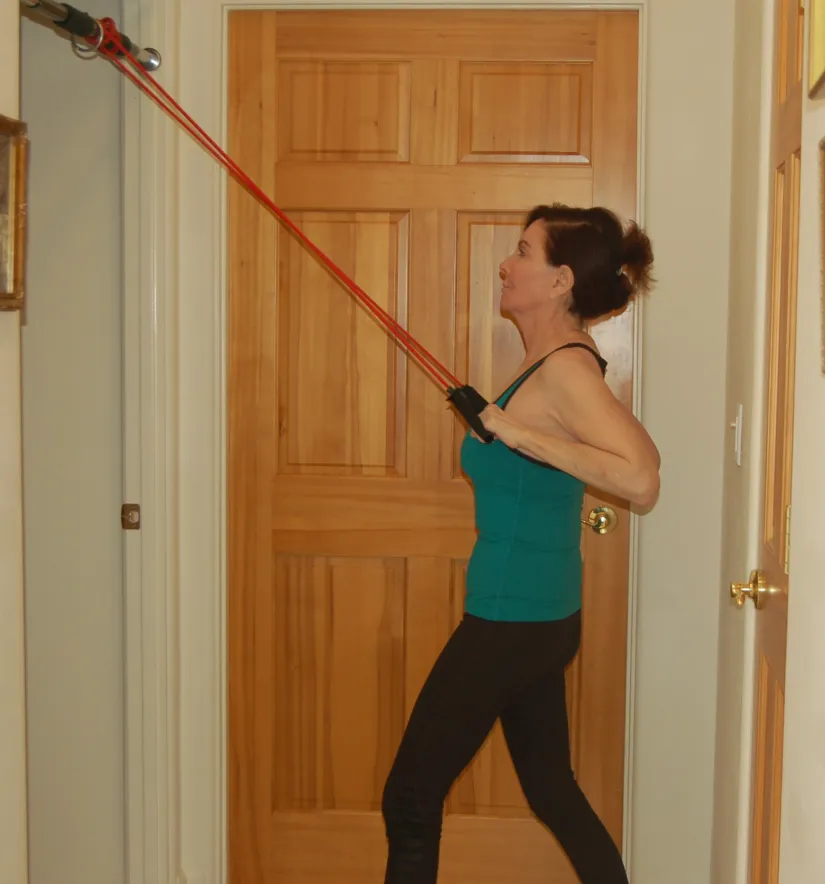
- This workout targets the arms, shoulders, and back muscles.
- Arrange your arms in front of you so that they are at chest height.
- Tightly grasp a resistance band using both hands. The band ought to run parallel to the earth.
- Pull the band towards your chest by extending your arms out to your sides while maintaining a straight-arm posture. Starting from your mid-back, perform this movement.
- Bring your shoulder blades together while maintaining a straight spine, and then slowly go back to the beginning position.
- Perform 1-3 sets of 15–20 repetitions.
Hip extension
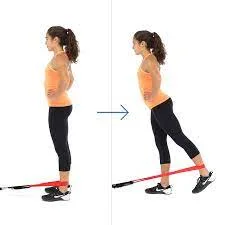
- Your legs and hip muscles will be worked during this exercise. To complete this exercise, you’ll need a band with light to medium resistance.
- Your two ankles should be looped with the resistance band. For balance, you can use a chair or wall.
- Continue to pull your left leg back as far as you can while maintaining a straight body line.
- Return to the starting position slowly.
- After 12 repetitions with your left leg, switch to your right leg.
- Start with two sets on each side and increase the number of sets to three as your strength increases.
Resistance band leg press

- This workout targets your glutes, hamstrings, calves, and quadriceps. This exercise forces you to work against gravity, much like a leg press on a weight machine.
- Raise your feet off the floor while lying on your back.
- The knees should be flexed to a ninety-degree angle. Point your toes upward as you flex your feet.
- Hold the ends of the resistance band as you wrap it around your feet.
- When your legs are fully extended, press your feet against the bands.
- To get back to a 90-degree angle, bend your knees.
- Do 1-3 sets of 10–12 repetitions.
How to cool down
After your workout, take five to ten minutes to cool down. This permits the descent of your heart rate and breathing into a resting state. Gentle stretches of involved muscle and spot walking are alternatives.
Resistance training dos
When you’re Resistance training, do:
- Raise the right amount of weight. Start with a weight that you can lift 12 to 15 times without difficulty.
- For the majority of people, strength training can be accomplished just as effectively with a single set of 12 to 15 repetitions at a weight that exhausts the muscles as with three sets of the same exercise. When you gain strength, gradually increase the weight.
- Use proper form. Place the right form. Acquire proficiency in all the exercises. Make sure you use your joints’ entire range of motion when lifting weights. Your results will improve and your risk of self-harm will decrease with improved form. Reduce the weight or the number of repetitions if you are unable to keep proper form. Keep in mind that even when you pick up and replace your weights on the weight racks, proper form counts.
- Consult with a personal trainer or other fitness expert if you’re not sure if you’re performing a certain exercise correctly.
- Breathe. Take a breath. As you lift weights, you may find it tempting to hold your breath. Release your breath. Rather, exhale when you raise the weight and inhale when you bring it down.
- Seek balance. Look for equilibrium. Work out all of your main muscles, such as those in your arms, shoulders, back, hips, legs, and abdomen. Build balanced strength in the opposing muscles, such as the arms’ front and back.
- Add strength training to your fitness routine. Incorporate strength training into your exercise schedule. At least twice a week, the U.S. Department of Health and Human Services advises including strength training activities for all major muscle groups in a fitness regimen.
- Rest. Don’t work out the same muscles twice in a row. You can schedule daily sessions for particular muscle groups, or you can work all of your major muscle groups in a single session two or three times a week.
Resistance training don’ts
Follow these tips to avoid common errors when you are on resistance training:
- Don’t skip the warmup. Avoid skipping the warm-up. Compared to warm muscles, cold muscles are more prone to injury. Warm up with five to ten minutes of brisk walking or another aerobic exercise before lifting weights.
- Don’t rush. Hold off. Use controlled, comfortable motion when moving the weight. Going slowly prevents you from relying on momentum to lift the weight and aids in the isolation of the desired muscles. After every exercise, take a minute or so to rest.
- Don’t overdo it. It’s usually sufficient for most people to perform one set of exercises until they become fatigued. More sets could require more time and increase the risk of overload injuries. Your fitness objectives, however, may determine a different number of sets that you complete.
- Don’t ignore pain. If an exercise hurts, you should quit. If possible, try the exercise with less weight or again in a few days.
- Don’t forget your shoes. When lifting weights, you can avoid falling and harming your feet by wearing shoes that offer protection and good traction.
Resistance training for beginners
People with medical conditions that may increase their risk of experiencing a health issue while engaging in physical activity are identified through pre-exercise screening. It helps as a safety net or filter to resolve whether exercising has more potential advantages for you than drawbacks.
The Australian Physical Activity and Sedentary Behaviour Guidelines recommend strengthening your body with workouts at least twice a week. All of your body’s major muscle groups your arms, shoulders, back, chest, core, and hips should be worked during these exercises.
Starting resistance training
To begin with, a standard strength training program for beginners includes eight to ten exercises that should be done two to three times a week, targeting the major muscle groups in the body.
Start with one set of each exercise, no more than twice a week, and as few as eight repetitions (reps) per set. Every other or third day, you should progressively increase to two to three sets of each exercise or eight to twelve repetitions. You should consider going harder once you can perform an exercise for 12 reps with comfort.
Advanced resistance training
To maximize the benefits of resistance training, gradually increase the level of intensity by your experience level and training objectives. This could involve lifting heavier weights, varying the length of the contraction (the amount of time you can hold the weight), cutting down on recovery time, or doing more training. You can gradually increase the intensity of your training as your muscles adapt after four to six weeks of consistent resistance training.
Studies show that receiving professional guidance and supervision could enhance your performance by guaranteeing that you adhere to safety protocols and utilize suitable techniques. Before continuing with your program, get in touch with a healthcare provider if you feel any pain or discomfort.
Repetitive maximum (RM) and resistance training
Maximal voluntary contraction (MVC), or the ability of a muscle to contract to its maximum capacity at any given moment, is the best method for building muscle strength. The term “maximum number of repetitions” (XRM) in resistance training refers to the number of repetitions that can be performed with a specific weight or resistance. X is the highest number of lifts that a particular weight can support before the muscles become fatigued.
The type of improvements that the muscles will make is determined by the RM range. For a beginner, 8–12 RM and for an advanced, 2–6 RM is the ideal range for increasing muscle strength.
Using the formula 7RM, for instance, an individual can lift a weight of, say, 50 kg, seven times before their muscles become too tired to handle it further. Higher weights translate into lower repetition maximums (RM); an individual could lift a 65 kg weight, but not more than seven times.
A higher repetition maximum (RM) is usually achieved with lower weights; for example, an individual can lift a 35 kg weight approximately 12 times before experiencing muscle fatigue. The MVC principles can assist you in getting the most out of your exercise. Once you can comfortably perform two repetitions over the maximum, it’s a good idea to only increase the weight by two to ten percent.
Reaching objectives for advanced resistance training with MVC
Resistance training is based on the principles of manipulating force, exercises, tempo, sets, and repetitions (reps) to overload a muscle group and achieve the desired change in strength, endurance, size, or shape.
The exact mix of repetitions, sets, exercises, resistance, and force will dictate the kind of muscle growth you attain. Generally speaking, using the RM range, the following
- Strengthening muscles: 1–5 repetitions per set, executed with force
- Muscle force: 1 – 6 RM per set, controlled.
- Muscle length: 6 – 12 RM, controlled.
- Muscle constancy: 12 – 15 or more RM per set, controlled.
Muscle recovery during advanced resistance training
After a workout, muscle needs time to grow and repair. Your muscles won’t grow larger or stronger if you don’t give them enough time to heal. Resting the affected muscle group for at least 48 hours is a good general rule of thumb.
You might want to think about a split program once you have enough resistance training experience and the backing of a permitted healthcare or exercise professional. On Mondays and Fridays, for example, you could work on your upper body, and on Wednesdays and Sundays, your lower body.
Gaining strength from advanced resistance training
A quick rise in strength is usually experienced by beginners, who then plateau or level out their gains. Gains in muscle mass and strength after that are earned through hard work.
The majority of your initial strength gain, when you begin resistance training, is caused by a process known as neural adaptation. This indicates that the muscles’ behavior is altered by the nerves that supply them. It is believed that more motor units are recruited to carry out the contraction as a result of more nerves firing more frequently, which results in a greater contraction of the muscles (a motor unit is made up of the muscle fibers that are connected to the nerve cell). This indicates that you’ve reached a plateau when you get stronger but your muscles stay the same size.
Never give up on your goals of increasing muscle size; muscle cells will eventually respond to consistent resistance training by growing larger (a process known as hypertrophy). If you strike a plateau, it’s a positive indication that you will soon make gains in muscle mass. There are several methods you can use to reduce the wall period.
You can overcome a plateau in your workouts by switching things up. According to the theory of variation, you can force your muscles to grow and become stronger by exposing them to a variety of unexpected stresses. When the muscles are forced to adapt, they will respond by becoming bigger and stronger.
Follow the guidance provided by your trainer or the gym instructor, however, here are some suggestions:
- Raise the number of repetitions.
- Increase the duration of your workout by ten or fifteen minutes.
- Increase the frequency of your workouts while recognizing that every muscle requires a minimum of 48 hours to recover. As you gain more experience, you might want to think about dividing up your body parts into different workout days. For instance, you could work on your back, biceps, and abdominal muscles in session two, your legs in session three, and your chest, shoulders, and triceps in session one.
- Change up your workouts; for example, concentrate on multi-muscle group exercises that are functional or specific that is, they connect to everyday tasks or athletic demands.
- Raise the weight by 5% to 10% approximately.
- Exercises like swimming or running can be used as cross-training.
- Approximately every four to eight weeks, switch up your workout to keep your muscles strong.
Is resistance training different than strength training?
Although the objectives of resistance training and resistance training are fairly similar, they differ slightly. resistance training is primarily focused on developing large, bulky muscles by consistently increasing the weight one lifts while also lowering the number of reps one performs. Strength training exercises, such as the aforementioned examples, require the resistance of an object or one’s body weight and are typically intended to build some muscle mass or toning.
The resistance component of strength training is usually accomplished by lifting weights, which adds an external stress that requires the muscle to work harder to overcome, according to University of Mississippi associate professor of Exercise Science Jeremy Loenneke, Ph.D. Stated differently, resistance training does not always necessitate the use of free weights, whereas resistance training does.
Summary
- Muscle strength is increased through resistance training, which involves working your muscles against a weight or force.
- Utilizing free weights, weight machines, resistance bands, and your body weight are among the various resistance training methods.
- For the best results, a beginner should exercise two or three times a week.
- To optimize strength and size gains, give each muscle group at least 48 hours of rest.
- By mixing up your workouts, you can overcome a training plateau.
- There are many advantages to resistance exercise. In addition to increasing strength and muscle tone, it also relieves stress, enhances balance, and enhances mental health. Additionally, it can help make daily tasks like stair climbing, grocery shopping, and gardening easier. For these reasons, resistance training ought to be a part of your regimen, particularly if your goal is to increase bone density and metabolism.
FAQ
How important is resistance training to health?
To keep your muscles strong and endurance, you must engage in resistance exercises. By lowering anxiety and depressive symptoms, it can also aid in enhancing your mental and emotional well-being. Because resistance training lowers resting blood pressure, it may also enhance cardiovascular health. It also affects the levels of cholesterol.
Can resistance training help you lose weight?
Increasing muscle mass helps impact the number of calories you burn doing everyday activities. The amount of calories you burn while performing daily tasks is impacted by increasing muscle mass. You will experience an increase in metabolism when you gain muscle mass.
Do I need to go to a gym to do resistance training?
There’s no need to join a gym to perform resistance training at home. Additionally, no specialized equipment is needed—all you need to do is use gravity and your body weight.
What is resistance training?
If you want to start resistance training, you can work it into your daily morning routine a few times per week. Alternatively, you can watch television and perform resistance training exercises during commercial breaks. The important thing is to exercise regularly.
Can you do resistance training every day?
The researchers suggest doing strength training, or resistance training, at least twice a week. If you’d like, you can work out more than twice a week. Just remember to pay attention to your body and take breaks when necessary.
What differentiates resistance training from strength training?
Strength training involves building a lot of muscle tissue by gradually increasing the weight you lift (while lowering the number of reps), which results in larger body gains in strength. Exercises involving resistance training involve pushing or pulling against an object, such as your own body.
References
- Department of Health & Human Services. (n.d.-b). Resistance training – health benefits. Better Health Channel. https://www.betterhealth.vic.gov.au/health/healthyliving/resistance-training-health-benefits
- LaMarco, N. M. (2022, June 13). What Is Resistance Training and Why Is it Important? Verywell Fit. https://www.verywellfit.com/what-is-resistance-training-3496094
- Cde, R. W. M. (2019, October 10). Resistance training exercises: Benefits, description & Examples. eMedicineHealth. https://www.emedicinehealth.com/strength_training/article_em.htm
- Resistance training | Strength, Endurance & Flexibility. (2024, January 30). Encyclopedia Britannica. https://www.britannica.com/topic/resistance-training/Skeletal-and-body-composition
- Today, U. (2023, December 15). Weightlifting or resistance training? Learn how to build strength and muscle mass. USA TODAY. https://www.usatoday.com/story/life/health-wellness/2023/05/27/what-is-resistance-training-examples-strength-training/70239764007/
- Cronkleton, E. (2019, September 5). How to get a Full-Body Strength Training workout at home. Healthline. https://www.healthline.com/health/exercise-fitness/strength-training-at-home
- Weight training: Do’s and don’ts of proper technique. (2022b, November 29). Mayo Clinic. https://www.mayoclinic.org/healthy-lifestyle/fitness/in-depth/weight-training/art-20045842




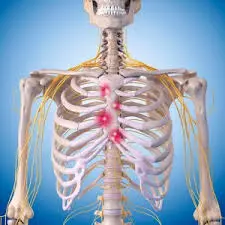


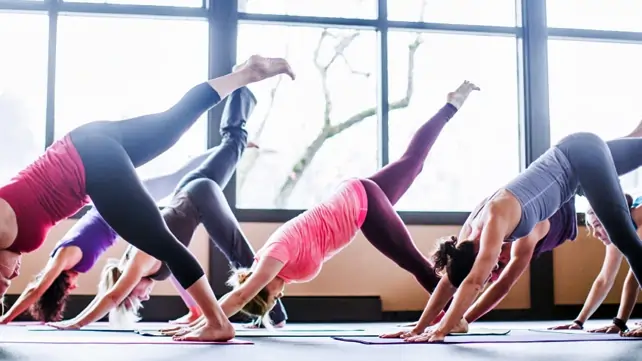
5 Comments